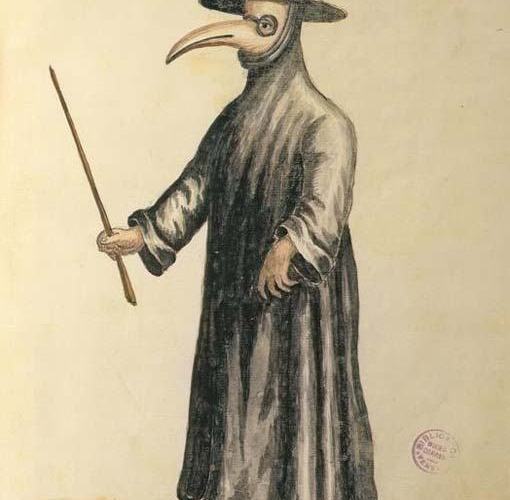On October 30th, 1938, a radio broadcast on the CBS Radio station "The War of…
Historic Epidemics: the Plague Doctor

The Black Death. The Bubonic plague. The Great Pestilence. The Great Mortality. Whatever name you choose, 60% of the world’s population died from it in the middle of the fourteenth century.
Debates continue on the hows, whens, and whys of the disease and its spread, but there is no refuting that the Great Mortality was the single-most devastating health crisis in the history of the world. In less than ten years, a bacteria carried by fleas on the backs of black rats laid waste to cities and towns, estates, palaces, and kingdoms. No one was immune to a disease that dealt a swift and gruesome death to rich and poor, old and young alike.
Much as I’d love to write about all the fascinating aspects of the plague — or better yet, write an novel about it! — I’ll focus on just one aspect in this post: the bird-like masks and leather suits worn by plague doctors.
One of the most prevalent medical theories of the middle ages was that of ‘bad air’– miasma as it was called at the time–caused disease (There’s a theory that the ring-around-the-rosy song came from this idea) This theory proves that although medieval doctors didn’t have all the information we have today, they were on the right track. But not completely. Most physicians believed the ‘bad air’ could be countered by ‘good air’ or at least air that smelled good. Thus, people often carried posies of fresh flowers or herbs to hold up to their faces when encountering a plague victim, believing it would save them from contracting the disease.
It was also to this purpose, medieval doctors developed what we might call an ancient hazmat suit consisting of:
-
tall, leather boots that looked a little like hip-waders
-
a long leather coat, oiled with herb-infused oil to make it smell good
-
gloves
-
a long pole
-
a mask with a long beak that looked like a bird and a broad-brimmed hat
Why the beak that made them look like some kind of birdlike grim reaper? That’s the interesting part. The beak was filled with good-smelling herbs, spices, and flowers so that the doctor could have the benefit of ‘good air’ while keeping his hands free. There were also cutouts for eyes–in later centuries covered in glass–to protect the doctor from the bad air entering through his eyes. The hat with a broad brim would identify him as a doctor.
The long pole was multi-functional. It is thought he might have used it to set aside the clothing of the infected or to keep patients at a distance — a medieval form of social distancing.

